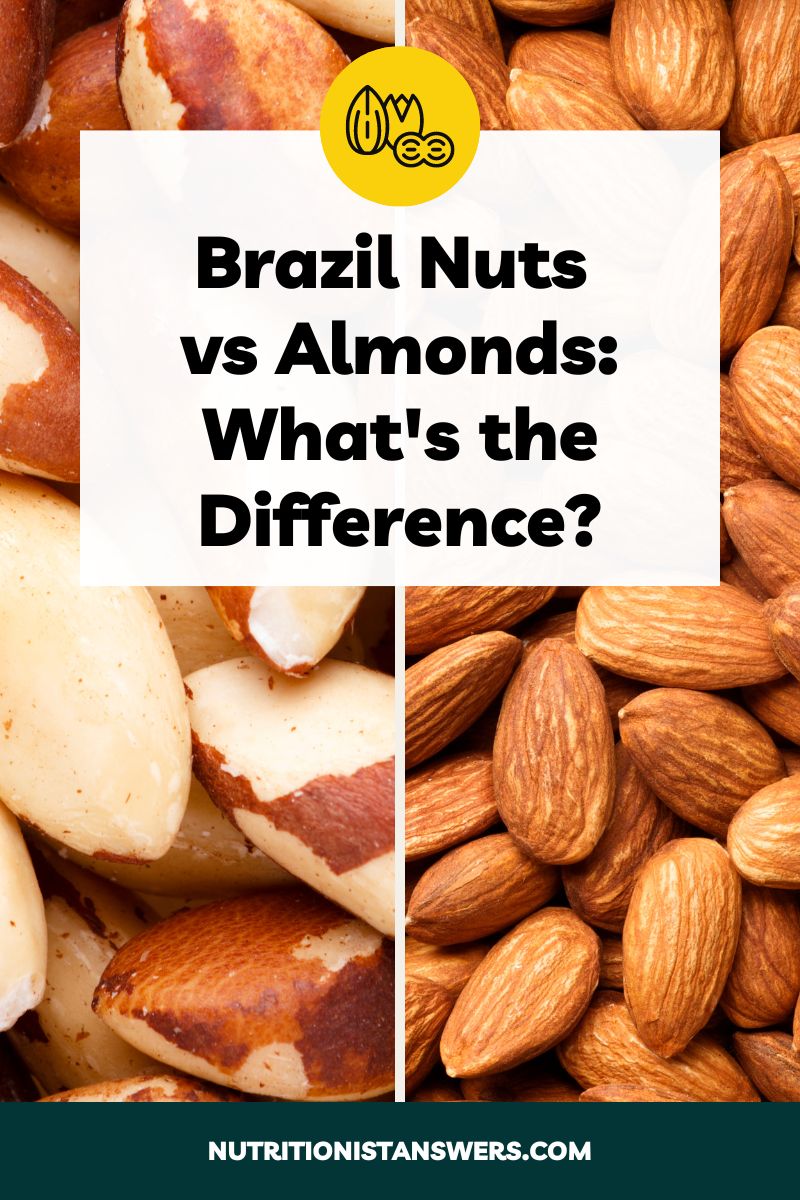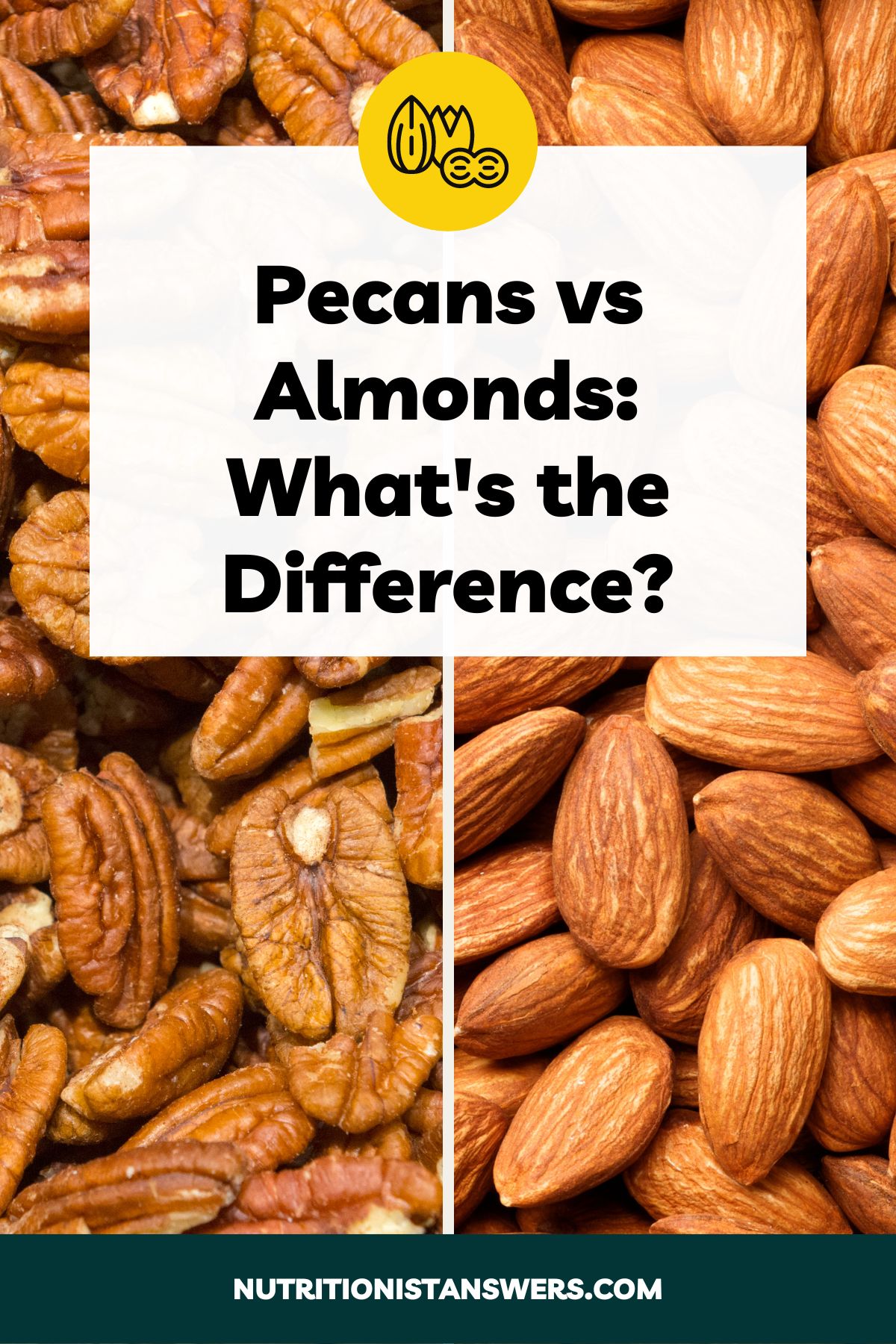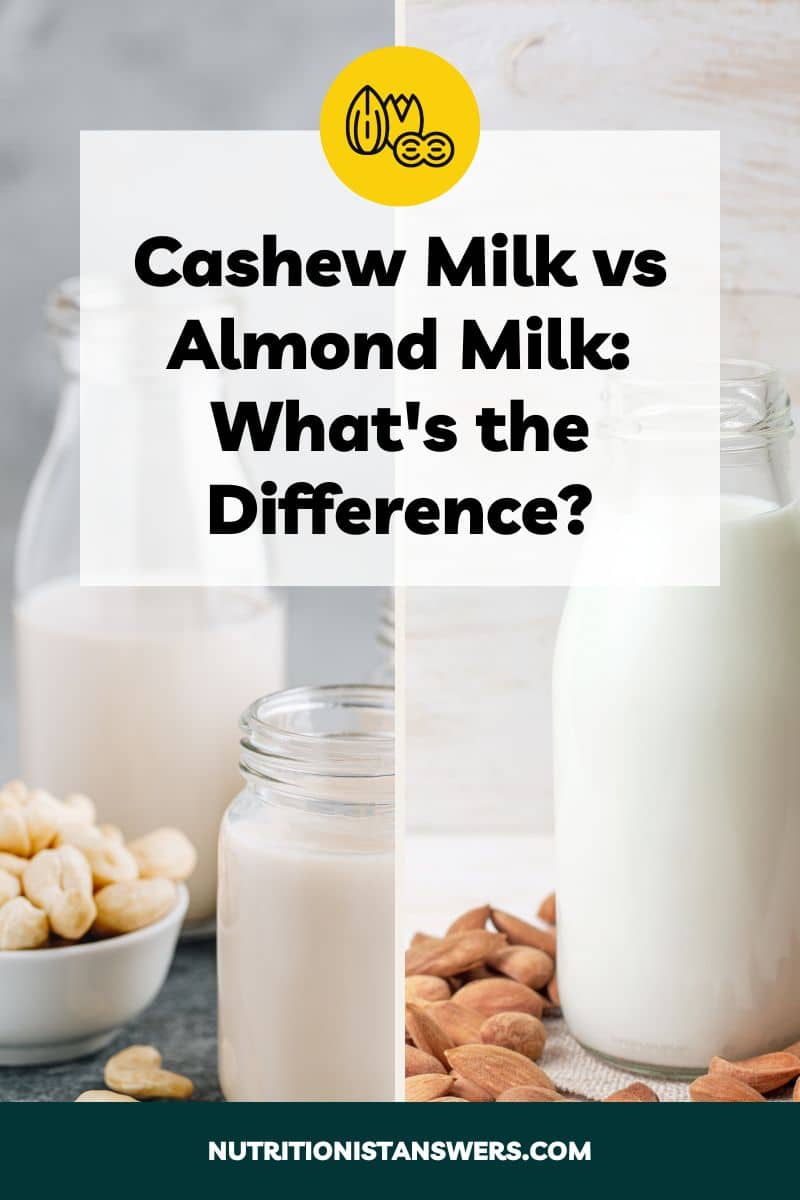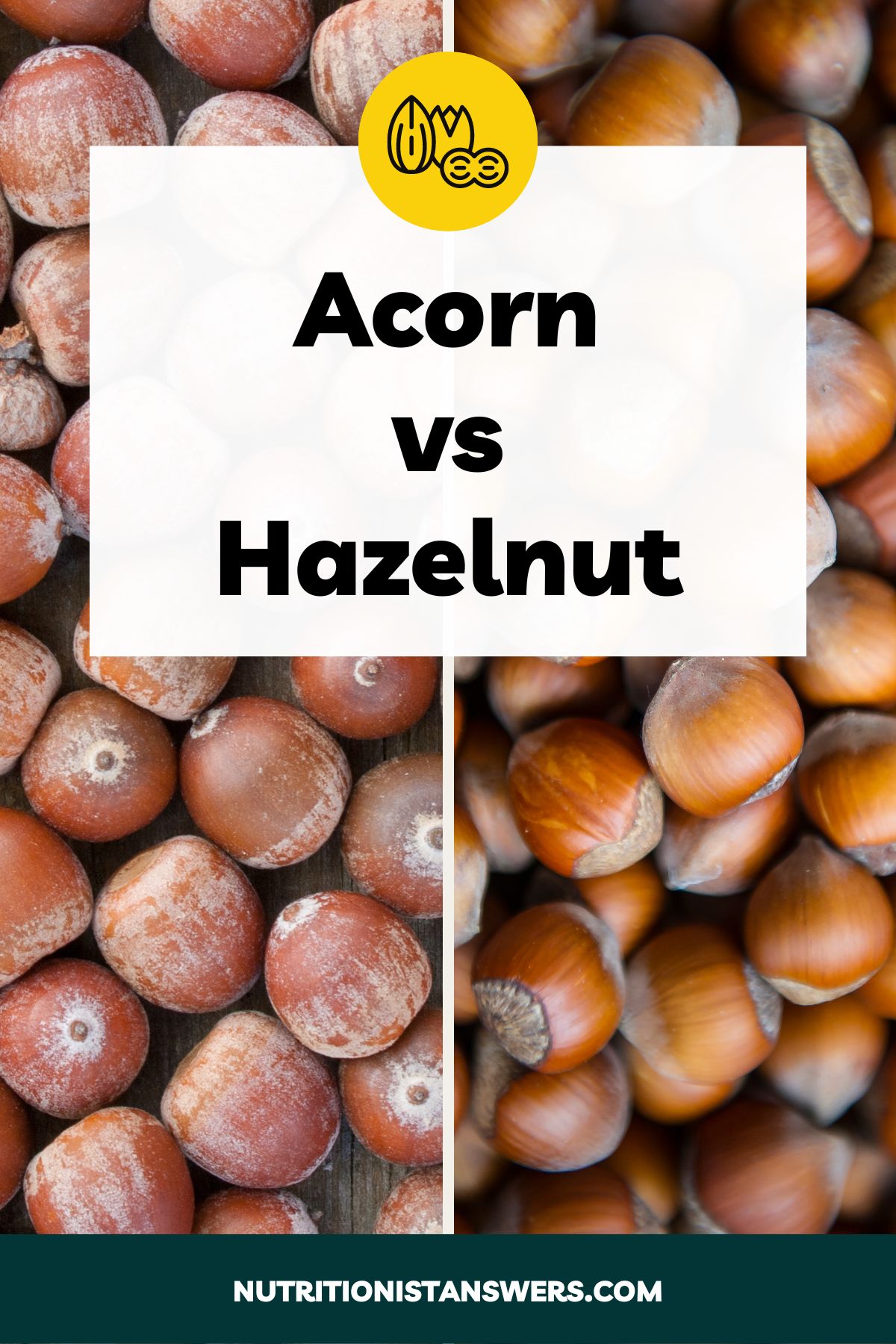Brazil nuts and almonds are two varieties of nuts that people love to snack on as well as use in cooking and baking.
Both are packed with nutrients, like protein, fiber, and healthy fats, but there are some important differences between these two nuts that you’ll want to be aware of.
In this article, we’ll explore the similarities and differences between Brazil nuts and almonds, in terms of nutrition, taste, available forms, prices, and uses.
Please note that this article contains affiliate links. If you click one of these links and make a purchase, we may earn a commission. As an Amazon Associate, we earn from qualifying purchases.
What are Brazil nuts?
Brazil nuts are tree nuts native to the Amazon rainforest in South America. They grow inside a hard, coconut-like fruit pod that contains up to 24 triangular nuts (1).
Brazil nuts have a woody, dark brown shell that can be cracked and removed. The edible kernel inside is large (1-2 inches long) and cream-colored with brown, papery skin.
If you’ve ever seen those giant wedge-shaped nuts floating around in your mixed nuts container – those are Brazil nuts.
They’re known for their mild flavor — earthy, buttery, and subtly sweet with a somewhat bitter aftertaste. They have a smooth buttery mouthfeel and a satisfying crunch.
While not as widely available as other nuts, you can find Brazil nuts at many supermarkets and health food stores, often in the snack aisle or bulk foods section. They can also be purchased online.
Brazil nuts are commonly eaten as a snack or added to trail mixes, granolas, and snack bars. They can also be chopped and used in baked goods or sprinkled over salads and other side dishes.
What are almonds?
Almonds are a type of tree nut produced by the almond tree (Prunus dulcis), which is native to Central Asia (2).
They have a hard, teardrop-shaped outer shell that must be cracked and removed to reveal the edible nut kernel inside, which is creamy white in color and covered by thin brown skin.
Almonds have a crunchy texture and a delicate, nutty flavor. They are slightly sweet with just a hint of bitterness.
You’ll find almonds in the baking aisle, snack aisle, or bulk foods section of most grocery stores and health food markets, and they can also be purchased online.
Almonds are incredibly versatile and can be eaten as a snack, tossed into salads, sprinkled over baked goods, or processed into almond milk or butter.
Brazil nuts vs almonds
Brazil nuts taste very buttery, with a bittersweet undertone, while almonds have a nuttier flavor and denser, crunchier texture.
Almonds are slightly higher in protein, carbohydrates, and fiber, while Brazil nuts contain more calories and fat.
Both nuts are rich sources of minerals and B vitamins. Brazil nuts are uniquely high in selenium, providing nearly 10 times the Daily Value (DV) in one serving, while almonds contain nearly 50% of the DV for vitamin E.
Here’s a more detailed review of how they compare in flavor, nutrition, available forms, prices, and recommended uses:
Flavor comparison
Almonds have a pleasant, sweet, nutty flavor with a dense, firm texture that becomes crunchier after roasting.
Brazil nuts are much larger than almonds. They taste buttery and earthy with a slightly bitter aftertaste.
The high oil content of Brazil nuts also gives them a rich, smooth mouthfeel that is distinct from almonds.
Because they’re both very mild, almonds and Brazil nuts pair well with a wide variety of flavors and aren’t as likely to overpower other ingredients in recipes.
Nutrition comparison
Here’s a side-by-side comparison of the calorie and macronutrient content of Brazil nuts and almonds, based on a 1-ounce (28-gram) serving size (3, 4):
| Nutrient | Brazil nuts, unroasted (28g) | Almonds, unroasted (28g) |
| Calories | 187 | 164 |
| Protein | 4 grams | 6 grams |
| Fat | 19 grams | 14 grams |
| Saturated fat | 5 grams | 1 gram |
| Monounsaturated fat | 7 grams | 9 grams |
| Polyunsaturated fat | 7 grams | 4 grams |
| Carbohydrates | 3 grams | 6 grams |
| Fiber | 2.1 grams | 3.5 grams |
Calories
Brazil nuts are 14% higher in calories than almonds due to their higher fat content.
A 1-ounce (28-gram) serving of Brazil nuts provides 187 calories, while the same serving of almonds offers 164 calories.
Protein
Almonds have over 50% more protein per serving than Brazil nuts (6 grams vs 4 grams, respectively.).
If you’re trying to include more protein in your diet, almonds would be the better nut choice.
Fat
Both Brazil nuts and almonds are high in fat, but Brazil nuts provide about 35% more fat per serving than almonds.
A 1-ounce (28-gram) serving of Brazil nuts contains 19 grams of fat, while an equal serving of almonds includes 14 grams of fat.
The extra fat makes Brazil nuts softer and gives them a more buttery mouthfeel, compared to almonds.
Brazil nuts are higher in saturated and polyunsaturated fats, while almonds are mostly made up of heart-healthy monounsaturated fats.
Carbohydrates
Like other nuts, Brazil nuts and almonds are low in carbohydrates.
Almonds have twice as many carbohydrates as Brazil nuts, providing 6 grams per serving compared to the 3 grams found in Brazil nuts.
So if you’re looking for a higher fat, lower carb snack option, Brazil nuts fit the bill.
Vitamins and minerals
Here’s an overview of the vitamin and mineral content of Brazil nuts and almonds, based on a 1-ounce (28-gram) serving (3, 4):
| Nutrient | Brazil nuts, unroasted (28g) | Almonds, unroasted (28g) |
| Vitamin A | 0 mcg RAE (0% DV) | 0 mcg RAE (0% DV) |
| Vitamin B1 (Thiamin) | 0.2 mg (17% DV) | 0.06 mg (5% DV) |
| Vitamin B2 (Riboflavin) | 0.01 mg (1% DV) | 0.3 mg (23% DV) |
| Vitamin B3 (Niacin) | 0.1 mg (1% DV) | 1 mg (6% DV) |
| Vitamin B5 (Pantothenic acid) | 0.05 mg (1% DV) | 0.1 mg (2% DV) |
| Vitamin B6 (Pyridoxine) | 0.03 mg (2% DV) | 0.04 mg (2% DV) |
| Vitamin B9 (Folate) | 6 mcg (2% DV) | 13 mcg (3% DV) |
| Vitamin B12 (Cobalamin) | 0 mcg (0% DV) | 0 mcg (0% DV) |
| Vitamin C | 0.2 mg (0% DV) | 0 mg (0% DV) |
| Vitamin D | 0 mcg (0% DV) | 0 mcg (0% DV) |
| Vitamin E | 1.6 mg (11% DV) | 7 mg (47% DV) |
| Vitamin K | 0 mcg (0% DV) | 0 mcg (0% DV) |
| Choline | 8 mg (1% DV) | 15 mg (3% DV) |
| Sodium | 1 mg (<1% DV) | 0.3 mg (<1% DV) |
| Potassium | 187 mg (4% DV) | 208 mg (4% DV) |
| Calcium | 45 mg (3% DV) | 76 mg (6% DV) |
| Phosphorus | 206 mg (16% DV) | 136 mg (11% DV) |
| Magnesium | 107 mg (25% DV) | 77 mg (18% DV) |
| Iron | 0.7 mg (4% DV) | 1.1 mg (6% DV) |
| Zinc | 1.2 mg (11% DV) | 0.9 mg (8% DV) |
| Copper | 0.5 mg (56% DV) | 0.3 mg (33% DV) |
| Manganese | 0.3 mg (13% DV) | 0.6 mg (26% DV) |
| Selenium | 544 mcg (989% DV) | 1 mcg (2% DV) |
Compared to almonds, Brazil nuts provide more thiamin (vitamin B1), phosphorus, magnesium, zinc, copper, and selenium.
Brazil nuts are actually one of the best sources of selenium, providing nearly 10 times the Daily Value (DV) in each 1-ounce (28-gram) serving.
Almonds, on the other hand, are significantly higher in riboflavin and manganese, providing more than 20% of the Daily Value (DV) of each. They also offer close to 50% of the DV for vitamin E.
Special Diets
If you’re following a special diet, you may be wondering whether Brazil nuts or almonds are a better choice for you.
Dairy free diet
Both Brazil nuts and almonds are naturally dairy-free.
Gluten free diet
Both almonds and Brazil nuts are naturally gluten-free and can be consumed on a gluten-free diet.
Ketogenic diet
Like most nuts, both almonds and Brazil nuts can be enjoyed as part of a keto diet due to their high fat and low carb content.
However, Brazil nuts are the better choice, because they contain 35% more fat and 50% fewer carbs than almonds.
Almonds have 6 grams of carbs and 3.5 grams of fiber per 1-ounce (28-gram) serving, while an equal portion of Brazil nuts contains 3 grams of carbs and 2 grams of fiber.
Low fat diet
Brazil nuts and almonds are very high in fat and may need to be limited on a low-fat diet.
Generally, low-fat diets limit fat to 30% or less of total daily calorie intake (x). On a 2,000-calorie diet, a single serving of Brazil nuts would take up at least 9% of calories from fat (about one-third of your daily fat allowance).
Almonds are a slightly better choice but still contribute at least 6% of calories from fat in a 2,000-calorie diet.
Low-FODMAP diet
Brazil nuts are low-FODMAP, but almonds are not, according to the Monash University FODMAP Diet app.
Brazil nuts are low in fermentable carbohydrates and can be safely consumed on the low-FODMAP diet in portions of up to 10 nuts. However, larger servings (16 nuts or more) contain moderate amounts of galactans.
A 1-ounce serving (about 20 nuts) of almonds is high in galactans. Almond butter and almond flour are also high in galactans in servings larger than 1 tablespoon and ⅓ cup, respectively.
Almonds can only be consumed on the low-FODMAP diet in portions of 10 almonds or less (roughly half the typical serving size for almonds).
Low sodium diet
Almonds and Brazil nuts are both naturally low in sodium. However, many nuts are salted and usually contain around 80 mg (or more) of sodium per serving.
If you’re following a low-sodium diet, which limits sodium to less than 2300 mg, you may want to choose unsalted or lightly salted nuts instead (x).
Vegetarian diet
Both Brazil nuts and almonds are plant-based and can be eaten on a vegetarian diet.
Vegan diet
Almonds and Brazil nuts are both vegan since they come from plants.
Available forms
1. Whole (Brazil nuts and almonds)
Almonds and Brazil nuts are usually sold whole with their shells removed.
You can easily find almonds at most supermarkets and health food stores, in the baking aisle, bulk foods section, or snack aisle. They can also be purchased in bulk online from Nuts.com.
Brazil nuts may not be available at all grocery stores. Check the snack aisle and bulk foods section, or consider purchasing them online. Nut Cravings is a brand that sells Brazil nuts on Amazon.
2. Pre-cut (almonds only)
Pre-cut nuts are a hassle-free option that can be eaten or used in recipes without any preparation.
You can find almonds that have been sliced or slivered (peeled and cut into tiny sticks) in the baking aisle or bulk foods section of the grocery store.
Brazil nuts are rarely available pre-cut. Instead, you can chop them yourself using a knife or by pulsing them a few times in a blender or food processor.
3. Flour (Brazil nuts and almonds)
Nut flours are often used to replace wheat flour in gluten-free baked goods, breaded meats, and more.
Almond flour is usually located in the baking aisle or bulk foods section of most supermarkets. You can also buy almond flour online.
Brazil nut flour is very rare but is sometimes available online through retailers such as ohnuts.com. Alternatively, you could make your own by pulsing Brazil nuts in a food processor or blender until finely ground.
4. Butters (Brazil nuts and almonds)
Almond butter is a popular alternative to peanut butter and can be found at most grocery stores, as well as online. Justin’s is a very popular brand with many flavors.
Brazil nut butter is very rare but is sometimes available at health food stores or online. Dastony is a brand that sells Brazil nut butter on Amazon.
Another option is to make your own Brazil nut butter using a food processor or high-powered blender.
5. Oil (Brazil nuts and almonds)
Brazil nut oil is bright yellow and has a very mild, nutty flavor. While it can be used in cooking, Brazil nut oil is more often sold for cosmetic purposes.
Almond oil (also called sweet almond oil) is a cooking oil made by pressing almonds. It is not the same as bitter almond oil, an essential oil extracted from bitter almonds (5)
Sweet almond oil has a mild, nutty flavor and a high smoke point of 221°C (430°F) (6). It’s great for baking, roasting, and frying, as well as adding flavor to salads and other side dishes.
6. Milks (almonds only)
Almond milk is a popular non-dairy milk product that can be found in both the refrigerated and shelf-stable sections of most grocery stores.
We couldn’t find any commercially available Brazil nut milk, but you can make your own using filtered water, Brazil nuts, a blender, and a nut milk bag (or cheesecloth).
Cost
Brazil nuts are 2-3 times more expensive than almonds.
A 1-pound (16-ounce) bag of Brazil nuts typically costs $10-16, while almonds cost $5-7 for the same amount.
To get the most bang for your buck, you can buy nuts in bulk and store them in the freezer — keeping them cool will help keep them from going rancid.
Recommended uses
Brazil nuts and almonds can be used in many of the same ways.
1. Trail mixes and snacks
Almonds and Brazil nuts are great for adding a crunchy texture and delicious nutty taste to trail mixes and snack bars.
Brazil nuts have a milder flavor with a creamier texture, while almonds are a little more sweet, nutty, and crunchy. We like to use both nuts in our trail mixes!
2. Baked goods and desserts
Using Brazil nuts and almonds can be an easy way to elevate your favorite baked goods and desserts.
Almonds have a mild but nutty flavor and crunchy texture, making them great for use in delicate desserts like biscotti and shortbread.
They are also a key ingredient in classic desserts like almond cake, amaretti cookies, and macarons.
Brazil nuts are even milder than almonds, so they can add texture and flavor to a variety of desserts, including cookies, cakes, breads, and bars.
They have a softer texture, making them great for blending into smooth, creamy desserts like ice cream and mousse.
3. Salads and side dishes
Brazil nuts and almonds are great for adding a satisfying crunch and some extra nutrition to salads and side dishes.
Both nuts are mild and can be paired with a variety of salad ingredients, including leafy greens, fresh fruit, and whole grains.
You can also grind almonds or Brazil nuts into a coarse meal and sprinkle them over roasted Brussels sprouts or steamed broccoli for extra flavor.
For best results, use roasted nuts — it enhances the flavor and gives them a more appealing, crunchier texture.
4. Breaded meats and fish
For a crunchier texture and richer, nuttier flavor, try adding Brazil nuts or almonds to the breading for meats and fish.
Use a food processor or blender to pulse the nuts until finely ground. Then, add them to a bowl with flour or breadcrumbs and any seasonings you want to include.
To cook the meat or fish, first dip it in beaten egg, then coat with the nutty breading mixture and fry or bake until cooked through.
Nuts have a tendency to burn quickly, so remember to adjust the cooking time accordingly. Aim for a golden brown crust that is crispy on the outside.
Brazil nuts and almonds complement both lean proteins like tilapia, cod, and chicken, and richer meats such as pork and salmon.
Final thoughts
Brazil nuts and almonds are both tree nuts with similarly mild flavors. Almonds are nuttier and sweeter with a crunchier texture, while Brazil nuts are earthier and have a softer, buttery texture.
Almonds are higher in protein, carbohydrates, and fiber, and they provide nearly 50% of the Daily Value for vitamin E. Brazil nuts are higher in fat and calories, and are one of the best food sources of selenium, with almost 10 times the DV.
Almonds and Brazil nuts are available in many different forms including flours, nut butters, and oils. Brazil nuts tend to cost 2-3 times more than almonds.
Both nuts can be used in many of the same ways, such as trail mixes, baked goods and desserts, salads, and breaded meats.
Curious how almonds compare to other nuts? Check out our articles on Almonds vs Pistachios, Almonds vs Cashews, Almonds vs Peanuts, Almonds vs Walnuts, and Almonds vs Pecans.
Amy Richter is a Registered Dietitian Nutritionist based in Missouri. She is an experienced nutrition writer and medical advisor for Healthline and Medical News Today. Amy is passionate about all things food-related and enjoys translating complex science into easy-to-understand articles.





